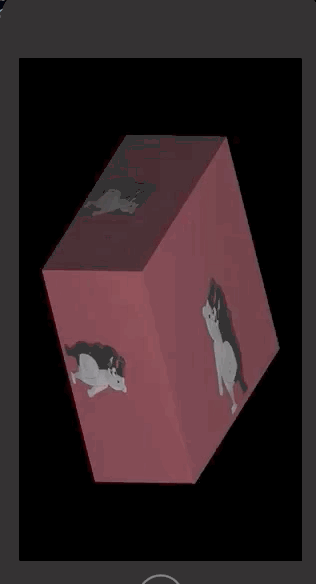一、绘制空白界面
上篇主要是显示一张简单的图片,这篇就进一步将图片换成一个立方体。
在上篇中是基于GLKViewController来创建GLKView的,这里就仅仅自定义一个GLKView添加在界面上。
首先还是需要一个GLKView界面、GLKBaseEffect着色器
@property (nonatomic, strong) GLKView *glkView;
@property (nonatomic, strong) GLKBaseEffect *baseEffect;
接下来需要对GLKView进行一些处理:
- 配置GLKView上下文
- 设置颜色缓冲、深度测试类型
//配置上下文
EAGLContext *context = [[EAGLContext alloc] initWithAPI:kEAGLRenderingAPIOpenGLES3];
if (!context) {
NSLog(@"context init faile");
}
[EAGLContext setCurrentContext:context];
self.glkView = [[GLKView alloc] initWithFrame:self.view.bounds context:context]; //关联上下文
self.glkView.backgroundColor = [UIColor brownColor];//背景色
self.glkView.drawableColorFormat = GLKViewDrawableColorFormatRGBA8888;//设置颜色缓冲
self.glkView.drawableDepthFormat = GLKViewDrawableDepthFormat24;//设置深度测试
glDepthRangef(1, 0);//深度测试范围
self.glkView.delegate = self;//代理
[self.view addSubview:self.glkView];
代理方法中需要清除一下颜色缓存与深度测试:
-(void)glkView:(GLKView *)view drawInRect:(CGRect)rect {
glClear(GL_COLOR_BUFFER_BIT | GL_DEPTH_BUFFER_BIT);
}
运行程序就可以看到一个棕色的界面。
二、配置纹理
使用熟悉的OC代码来获取一个图片数据,转化为UIImage:
NSString *path = [[[NSBundle mainBundle] resourcePath] stringByAppendingPathComponent:@"2.jpg"];
UIImage *image = [UIImage imageWithContentsOfFile:path];
接下来就是将纹理添加到着色器上并使用光照着色器,使立方体更有立体感:
//纹理信息
NSDictionary *option = @{GLKTextureLoaderOriginBottomLeft : @(YES)};
GLKTextureInfo *info = [GLKTextureLoader textureWithCGImage:image.CGImage options:option error:nil];
//初始化着色器配置
self.baseEffect = [[GLKBaseEffect alloc] init];
self.baseEffect.texture2d0.name = info.name;
self.baseEffect.texture2d0.target = info.target;
//开启光照
self.baseEffect.light0.enabled = YES;
self.baseEffect.light0.diffuseColor = GLKVector4Make(1, 1, 1, 1);
self.baseEffect.light0.position = GLKVector4Make(-0.5, -0.5, 5, 1);
三、配置顶点数据
为了使顶点数据的可读性更高,这里就使用一个结构体数组来保存顶点数据:
typedef struct {
GLKVector3 positionCoord; //顶点坐标
GLKVector2 textureCoord; //纹理坐标
GLKVector3 normal; //法线
} GVertex;
并且定义一个结构体属性以及顶点缓冲区:
@property (nonatomic, assign) GVertex *vertices;
@property (nonatomic, assign) GLuint vertexBuffer;//顶点缓冲区
设置6个面的顶点数据:
//顶点数据
self.vertices = malloc(sizeof(GVertex) * kCoordCount);
// 前面
self.vertices[0] = (GVertex){{-0.5, 0.5, 0.5}, {0, 1}, {0, 0, 1}};
self.vertices[1] = (GVertex){{-0.5, -0.5, 0.5}, {0, 0}, {0, 0, 1}};
self.vertices[2] = (GVertex){{0.5, 0.5, 0.5}, {1, 1}, {0, 0, 1}};
self.vertices[3] = (GVertex){{-0.5, -0.5, 0.5}, {0, 0}, {0, 0, 1}};
self.vertices[4] = (GVertex){{0.5, 0.5, 0.5}, {1, 1}, {0, 0, 1}};
self.vertices[5] = (GVertex){{0.5, -0.5, 0.5}, {1, 0}, {0, 0, 1}};
// 上面
self.vertices[6] = (GVertex){{0.5, 0.5, 0.5}, {1, 1}, {0, 1, 0}};
self.vertices[7] = (GVertex){{-0.5, 0.5, 0.5}, {0, 1}, {0, 1, 0}};
self.vertices[8] = (GVertex){{0.5, 0.5, -0.5}, {1, 0}, {0, 1, 0}};
self.vertices[9] = (GVertex){{-0.5, 0.5, 0.5}, {0, 1}, {0, 1, 0}};
self.vertices[10] = (GVertex){{0.5, 0.5, -0.5}, {1, 0}, {0, 1, 0}};
self.vertices[11] = (GVertex){{-0.5, 0.5, -0.5}, {0, 0}, {0, 1, 0}};
// 下面
self.vertices[12] = (GVertex){{0.5, -0.5, 0.5}, {1, 1}, {0, -1, 0}};
self.vertices[13] = (GVertex){{-0.5, -0.5, 0.5}, {0, 1}, {0, -1, 0}};
self.vertices[14] = (GVertex){{0.5, -0.5, -0.5}, {1, 0}, {0, -1, 0}};
self.vertices[15] = (GVertex){{-0.5, -0.5, 0.5}, {0, 1}, {0, -1, 0}};
self.vertices[16] = (GVertex){{0.5, -0.5, -0.5}, {1, 0}, {0, -1, 0}};
self.vertices[17] = (GVertex){{-0.5, -0.5, -0.5}, {0, 0}, {0, -1, 0}};
// 左面
self.vertices[18] = (GVertex){{-0.5, 0.5, 0.5}, {1, 1}, {-1, 0, 0}};
self.vertices[19] = (GVertex){{-0.5, -0.5, 0.5}, {0, 1}, {-1, 0, 0}};
self.vertices[20] = (GVertex){{-0.5, 0.5, -0.5}, {1, 0}, {-1, 0, 0}};
self.vertices[21] = (GVertex){{-0.5, -0.5, 0.5}, {0, 1}, {-1, 0, 0}};
self.vertices[22] = (GVertex){{-0.5, 0.5, -0.5}, {1, 0}, {-1, 0, 0}};
self.vertices[23] = (GVertex){{-0.5, -0.5, -0.5}, {0, 0}, {-1, 0, 0}};
// 右面
self.vertices[24] = (GVertex){{0.5, 0.5, 0.5}, {1, 1}, {1, 0, 0}};
self.vertices[25] = (GVertex){{0.5, -0.5, 0.5}, {0, 1}, {1, 0, 0}};
self.vertices[26] = (GVertex){{0.5, 0.5, -0.5}, {1, 0}, {1, 0, 0}};
self.vertices[27] = (GVertex){{0.5, -0.5, 0.5}, {0, 1}, {1, 0, 0}};
self.vertices[28] = (GVertex){{0.5, 0.5, -0.5}, {1, 0}, {1, 0, 0}};
self.vertices[29] = (GVertex){{0.5, -0.5, -0.5}, {0, 0}, {1, 0, 0}};
// 后面
self.vertices[30] = (GVertex){{-0.5, 0.5, -0.5}, {0, 1}, {0, 0, -1}};
self.vertices[31] = (GVertex){{-0.5, -0.5, -0.5}, {0, 0}, {0, 0, -1}};
self.vertices[32] = (GVertex){{0.5, 0.5, -0.5}, {1, 1}, {0, 0, -1}};
self.vertices[33] = (GVertex){{-0.5, -0.5, -0.5}, {0, 0}, {0, 0, -1}};
self.vertices[34] = (GVertex){{0.5, 0.5, -0.5}, {1, 1}, {0, 0, -1}};
self.vertices[35] = (GVertex){{0.5, -0.5, -0.5}, {1, 0}, {0, 0, -1}};
下面就是重要的部分,需要将顶点数据从内存中拷贝到显存当中,为了GPU能更快的读取到数据。由于使用了顶点、纹理、光照,所以需要打开三个通道:
//从内存拷贝入显存
glGenBuffers(1, &_vertexBuffer);//声明顶点数据
glBindBuffer(GL_ARRAY_BUFFER, _vertexBuffer);//绑定顶点数据
GLsizeiptr bufferSizeBytes = sizeof(GVertex) * kCoordCount;//顶点数据大小
glBufferData(GL_ARRAY_BUFFER, bufferSizeBytes, self.vertices, GL_STATIC_DRAW);//存入显存
//打开通道、设置数据读取方式
glEnableVertexAttribArray(GLKVertexAttribPosition);
glVertexAttribPointer(GLKVertexAttribPosition, 3, GL_FLOAT, GL_FALSE, sizeof(GVertex), NULL + offsetof(GVertex, positionCoord));
glEnableVertexAttribArray(GLKVertexAttribTexCoord0);
glVertexAttribPointer(GLKVertexAttribTexCoord0, 2, GL_FLOAT, GL_FALSE, sizeof(GVertex), NULL + offsetof(GVertex, textureCoord));
glEnableVertexAttribArray(GLKVertexAttribNormal);
glVertexAttribPointer(GLKVertexAttribNormal, 3, GL_FLOAT, GL_FALSE, sizeof(GVertex), NULL + offsetof(GVertex, normal));
四、设置定时旋转
这里使用一个CADisplayLin定时器实现立方体每一次的角度偏转
定义一个定时器属性以及角度属性用来记录角度:
@property (nonatomic, strong) CADisplayLink *displayLink;//定时器
@property (nonatomic, assign) NSInteger angle;//角度
每一次渲染都会讲角度旋转5度:
- (void)addCADisplayLink {
self.angle = 0;
self.displayLink = [CADisplayLink displayLinkWithTarget:self selector:@selector(update)];
[self.displayLink addToRunLoop:[NSRunLoop currentRunLoop] forMode:NSRunLoopCommonModes];
}
- (void)update {
//每次旋转5度
self.angle = (self.angle + 5) % 360;
//着色器旋转(角度转化为弧度)
self.baseEffect.transform.modelviewMatrix = GLKMatrix4MakeRotation(GLKMathDegreesToRadians(self.angle), 0.3, 1, 0.7);
//开始绘制(会调用代理方法)
[self.glkView display];
}
开始绘制之后来到代理方法,就需要开启深度测试以及开始绘制:
-(void)glkView:(GLKView *)view drawInRect:(CGRect)rect {
glEnable(GL_DEPTH_TEST);//开启深度测试
glClear(GL_COLOR_BUFFER_BIT | GL_DEPTH_BUFFER_BIT);//清空缓冲区
[self.baseEffect prepareToDraw];//准备绘制
glDrawArrays(GL_TRIANGLES, 0, kCoordCount);//开始绘制(三角形)
}
最终结果如下:
